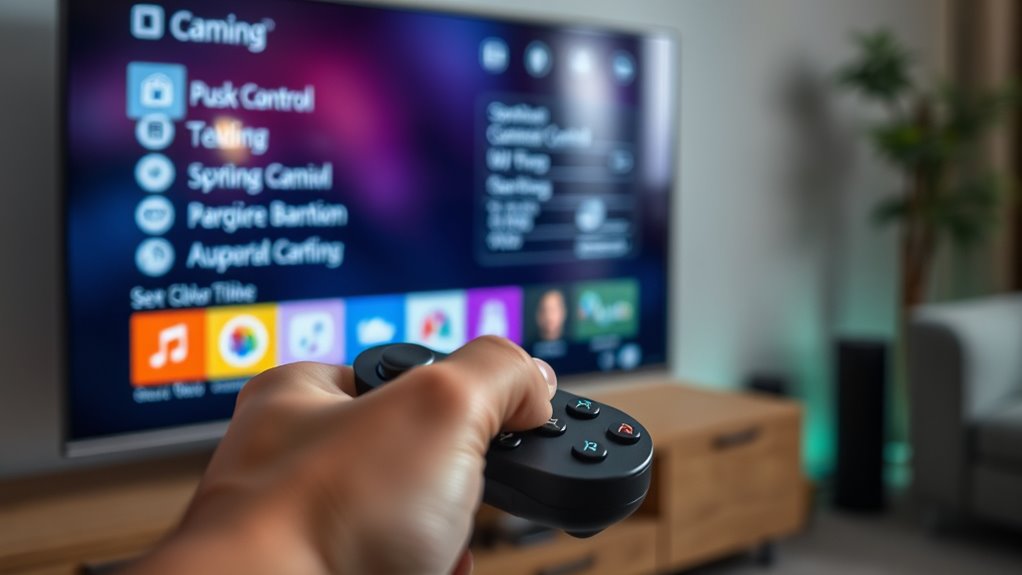To establish parental controls on gaming consoles, start by accessing the console’s settings or companion app. Create a family account, add your child’s profile, and verify it securely. Then, customize restrictions like content filters, playtime limits, and online access. You can also set scheduled play times and require approval for purchases. Monitoring tools help you stay connected and ensure a safe gaming experience. Keep exploring these options to learn how to optimize your controls further.
Key Takeaways
- Access parental control settings through console menus or companion apps specific to PlayStation, Nintendo Switch, or Xbox.
- Create a family group or user profiles, then set restrictions on content, playtime, and online interactions.
- Verify user identities with email or password prompts to secure control modifications.
- Customize restrictions such as mature content, purchase approvals, and scheduled gaming times.
- Enable notifications to stay informed about changes or attempts to modify parental controls.

Setting up parental controls on gaming consoles is an essential step to guarantee your children enjoy safe and age-appropriate gaming experiences. These controls help you manage what your kids can access, how long they can play, and monitor their online interactions. By configuring these settings, you can create a safer gaming environment tailored to your child’s age and maturity level.
Most major gaming platforms, including PlayStation, Nintendo Switch, and Xbox, offer built-in parental control features. You can manage these controls either directly through the console’s settings or via companion apps. These apps typically provide a user-friendly interface, making it easier to adjust restrictions remotely. When setting up parental controls, you’ll receive notifications if your child tries to modify any restrictions, ensuring you’re always aware of any changes made.
Major gaming platforms offer user-friendly parental controls accessible through settings or companion apps.
On PlayStation consoles, setting up parental controls involves creating a family group through Settings > Family and Parental Controls > Family Management**. Here, you add your child’s account, which can be verified via email to ensure security. You can then customize specific features for each child, such as restricting mature content, limiting playtime**, or preventing changes to privacy settings. The console allows you to specify who can alter these controls, and you’ll be notified if any modifications occur, giving you peace of mind that settings remain intact.
Nintendo Switch offers similar controls, accessible through the console itself or a dedicated smart device app. You can impose restrictions across all users on the console, set playtime limits, and schedule bedtime alarms through the app. Managing purchases is straightforward, as restrictions on the Nintendo eShop require your password, preventing unauthorized buying. These controls help you regulate content and spending, ensuring your child’s gaming remains appropriate and within your guidelines.
Xbox consoles feature robust family management options via the Xbox Family Settings app or directly through console menus. You can restrict access to mature content, control online interactions, and set daily or weekly playtime limits. The system also allows you to schedule designated screen-free periods and require approval for purchases. Activity monitoring tools provide insights into your child’s gaming and online behaviors, enabling you to intervene if necessary. Additionally, cookie management can be used to tailor online experiences and improve parental oversight.
Utilizing parental controls offers numerous benefits, including filtering inappropriate content, promoting responsible gaming habits, and ensuring online safety. They also help you stay informed about your child’s activities and adjust restrictions as they grow. Many resources, such as ESRB ratings and detailed parental guides, are available to help you make informed decisions. Online support from console providers can assist you in the setup process, ensuring you establish effective controls that suit your family’s needs. By investing a little time upfront, you create a safer gaming environment that balances fun with responsibility.
Frequently Asked Questions
Can Parental Controls Be Bypassed on Gaming Consoles?
Yes, parental controls on gaming consoles can be bypassed, but it’s not always easy. People might use methods like resetting the console, using alternative devices like PCs or tablets, or exploiting override codes. Some may even contact customer support through social engineering. To stay protected, you should keep your console’s software updated, set strong passwords, and monitor for any suspicious activity to maintain control over your child’s gaming experience.
How Often Should I Review Parental Control Settings?
You should review your parental control settings regularly to keep up with your child’s development and changing interests. Monthly or quarterly checks work well, especially if your child’s gaming habits evolve quickly. Also, review after holidays, major updates, or if you notice any concerning behavior. Frequent reviews help you stay aware of new content, guarantee restrictions are effective, and keep your child’s online safety a top priority.
Are There Differences in Parental Controls Across Console Brands?
You’re wondering if parental controls differ across console brands. Yes, they do. Nintendo offers a user-friendly app for managing settings remotely, with extensive communication controls. PlayStation provides robust options for game time and online interactions, while Xbox uses PIN-protected controls through Microsoft Family Safety. Each brand emphasizes certain features, so you’ll find variations in setup, scope, and management, making it important to explore each console’s specific parental control options.
Can Parental Controls Restrict In-Game Chat and Communication?
Did you know over 60% of parents worry about online communication in games? Parental controls can restrict in-game chat and communication features, giving you control over your child’s interactions. You can set limits on voice chat, messaging, and even review chat history. Most consoles let you approve or deny communication requests, making it easier to keep your child safe while they game. Regularly manage these settings to stay protected.
Do Parental Controls Affect Online Multiplayer Access?
You might wonder if parental controls impact online multiplayer access. They definitely can. You can restrict or block multiplayer features altogether, based on age or game content. Controls also limit who your child can communicate with during gameplay, like only friends or no one at all. Some consoles even require your permission for cross-network play. So, yes, parental controls play a vital role in managing your child’s online multiplayer experience.
Conclusion
Think of setting up parental controls like planting a garden—you nurture and protect what’s precious. When I helped my friend set controls for his kids’ console, he realized it was like installing a fence around that garden, keeping out weeds and unwanted guests. With these tools in place, you’re giving your kids the space to enjoy gaming safely, just like tending a healthy, thriving garden. Now, you’re in control, and their gaming experience stays positive and protected.










